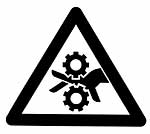Getting the Message Across
On-the-job training can help eliminate workers' confusion about or complacency toward warning symbols.
- By Mary Lesch
- Dec 01, 2004
 INTENDED to remind workers of safety hazards, warning signs are not necessarily the quick and easy safety reminders they are supposed to be. Because of overexposure, workers may become used to the signs and ignore or become immune to the message, placing themselves in a dangerous situation. Additionally, the sign's message, which uses universally accepted symbols designed to cross over multiple languages and cultures, is often so generic or abstract that it fails to adequately convey the nature of the hazard.
INTENDED to remind workers of safety hazards, warning signs are not necessarily the quick and easy safety reminders they are supposed to be. Because of overexposure, workers may become used to the signs and ignore or become immune to the message, placing themselves in a dangerous situation. Additionally, the sign's message, which uses universally accepted symbols designed to cross over multiple languages and cultures, is often so generic or abstract that it fails to adequately convey the nature of the hazard.
To improve the effectiveness of warning signs, use on-the-job training to help eliminate any confusion--and complacency--that may surround a safety message. A recent study from the Liberty Mutual Research Institute for Safety shows a 20 percent improvement in comprehension of warning symbols by individuals who receive training using accident scenarios.
To start your training program:
* Walk around your operations and observe how your employees work. Do they notice the posted warning signs, or do they walk right past them? Do employees consistently adhere to safety procedures, or do they take short cuts?
* Look over your loss history. Which parts of your operation generate the most accidents? Are there trends when accidents occur more frequently, such as during busy periods or when employees cover for one another?
* Take a close look at current warning signs. Are the signs legible, or are they old, faded, and hard to read? Do the signs meet current safety standards, such as a picture indicating the hazard instead of an outdated, text-only warning? Machine manufacturers are great resources to tap into when searching for the most appropriate replacement signs.
Heeding the Warnings
Once you've done your research, you're ready to start your on-the-job training program.
Organize your training by first discussing typical equipment operating procedures out on the plant floor: how the machine operates, what happens when it jams, and how to know when it needs maintenance. Describe, but do not demonstrate, the wrong way to approach a problem, along with the consequences of not doing the job safely.
Point out the warning signs to make the connection to the hazard. Then tell employees how to fix the problem the right way.
Often, the shortcuts workers develop to solve a problem or speed up production reduce their safety. This is especially true with long-time employees who may have developed unsafe habits that could harm themselves and new employees they might train.
By using accident scenario training, you emphasize the true consequences of safety shortcuts and help employees avoid being in these situations:
* A worker climbed into a confined space without a respirator to quickly check out a problem. He couldn't hold his breath as long as he thought, and the fumes quickly overcame him. Unfortunately, several of his co-workers also died as each one entered the space to save him and were overcome by the same fumes.
* Employees working on a printing press found the easiest way to clean the rollers was to run a rag over them during operations. Sadly, one day the rollers caught the rag, pulled in a worker's hand, and "degloved" it--peeling the skin right off.
* Instead of locking out a stone crushing machine for maintenance, a worker simply stopped the hammers and climbed in to check out a problem. While he was under the hammers, an employee turning on another machine accidentally threw the wrong switch, crushing his fellow worker to death.
Reinforcement and Resonance
To ensure that any employee you train heard--and understood--what you were saying, ask an open-ended question at the end of training, such as: Tell me what you will do if a jam occurs or the belt jumps?
Added benefits of this training are the results with new employees and employees of varying language backgrounds, who better understand your operations regardless of their relative unfamiliarity with the industry or the language.
Your goal is to have your employees return home as healthy as when they arrived. Use accident scenario training to reinforce the meaning behind warning signs so their messages will not only be clear, but also will continue to register with your employees long after they stop "seeing" the sign.
This article originally appeared in the December 2004 issue of Occupational Health & Safety.